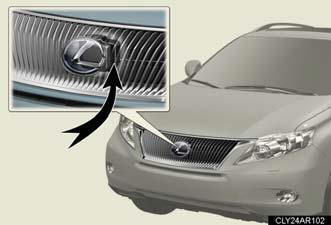Pre-Collision System
When the radar sensor detects an unavoidable frontal collision, safety
systems
such as the brakes and seat belts are automatically engaged in an
attempt to lessen vehicle damage.
Pre-collision seat belts (front seat belts only)
If the pre-collision sensor detects that a collision is unavoidable, the
precollision
system will retract the seat belt before the collision occurs.
The same will happen if the driver makes an emergency braking or loses control of the vehicle.
However, the system will not operate in the event of skidding when the TRAC/VSC systems are disabled.
Pre-collision brake assist
When there is a high possibility of a frontal collision, the system applies greater braking force in relation to how strongly the brake pedal is depressed.
Radar sensor

The radar sensor detects vehicles or other obstacles on or near the road ahead and determines whether a collision is imminent based on the position, speed, and heading of the obstacles.
The pre-collision system is operational when
Pre-collision seat belts linked to the radar sensor Х Vehicle speed is greater than about 3 mph (5 km/h).
Х The speed at which your vehicle is approaching the obstacle or oncoming vehicle is greater than about 18 mph (30 km/h).
Х The front occupants are wearing a seat belt.
Pre-collision seat belts in the event of sudden braking or skidding Х Vehicle speed is greater than about 18 mph (30 km/h).
Х The system detects sudden braking or skidding.
Х The front occupants are wearing a seat belt.
Pre-collision brake assist Х Vehicle speed is greater than about 18 mph (30 km/h).
Х The speed at which your vehicle is approaching the obstacle or the vehicle running ahead of you is greater than about 18 mph (30 km/h).
Х The brake pedal is depressed.
Conditions that may trigger the system even if there is no danger of collision
When there is an object by the roadside at the entrance to a curve.
When passing an oncoming vehicle on a curve.
When driving over a narrow iron bridge.
When there is a metal object on the road surface.
When driving on an uneven road surface.
When passing an oncoming vehicle on a left-turn.
When your vehicle rapidly closes on the vehicle in front.
When the system is activated in the situations described above, there is also a
possibility
that the seat belts will retract quickly and the brakes will be applied with a
force
greater than normal. When the seat belt is locked in the retracted position,
stop the
vehicle in a safe place, release the seat belt and refasten it.
Obstacles not detected
The sensor cannot detect plastic obstacles such as traffic cones. There may
also be
occasions when the sensor cannot detect pedestrians, animals, bicycles,
motorcycles,
trees, or snowdrifts.
When there is a malfunction in the system
Warning lights and/or warning messages will turn on or flash.
Certification
- For vehicles sold in U.S.A.
FCC ID: HYQDNMWR005
This device complies with Part 15 of the FCC Rules. Operation is subject to the
following
two conditions: (1) this device may not cause harmful interference, and (2)
this device must accept any interference received, including interference that
may
cause undesired operation.
FCC WARNING
Changes or modifications not expressly approved by the party responsible for
compliance could void the user's authority to operate the equipment.
Radio frequency radiation exposure Information:
This equipment complies with FCC radiation exposure limits set forth for an
uncontrolled
environment.
This equipment should be installed and operated with minimum distance of 20 cm between the radiator and your body.
This transmitter must not be co-located or operating in conjunction with any
other
antenna or transmitter.
- For vehicles sold in Canada.
Operation is subject to the following two conditions: (1) this device may not
cause
interference, and (2) this device must accept any interference, including
interference
that may cause undesired operation of the device.
CAUTION:
Limitations of the pre-collision system
Do not rely on the pre-collision system. Always drive safely, taking care to
observe
your surroundings and checking for any obstacles or other road hazards.
When the sensor may not be correctly detecting the vehicle ahead
Apply the brakes as necessary in any of the following situations:
When water or snow thrown up by the surrounding vehicles hinders the
functioning
of the sensor.
When your vehicle is pointing upwards (caused by a heavy load in the luggage compartment etc.).
Vehicles that cut in suddenly.
Vehicles with small rear ends (trailers with no load on board etc.).
Motorcycles traveling in the same lane.
Handling the radar sensor
Observe the following to ensure the pre-collision system can function
effectively:
Keep the sensor and front grille clean at all times.
Clean the sensor and front grille with a soft cloth so you do not mark or damage them.
Do not subject the sensor or surrounding area to a strong impact.
If the sensor moves even slightly off position, the system may malfunction. If
the
sensor or surrounding area is subject to a strong impact, always have the area
inspected and adjusted by your Lexus dealer.
Do not disassemble the sensor.
Do not attach accessories or stickers to the sensor, grille or surrounding area.
Do not modify or paint the sensor and grille cover.
See also:
Vanity mirror
The light turns on when the
cover is opened. ...
F-Sport Performance Accessories Available for GS
The available F-Sport Performance Accessories for Lexus GS 350 and GS 460
include performance enhancing parts such as 19-inch forged alloy wheels, brake
upgrades, suspension systems, air intake, e ...
Extended trunk
Long objects can be loaded in the vehicle by utilizing the trunk space and
rear seat area.
Pull down the armrest.
Open the armrest door.
The armrest door can be locked
and unlocked using the
...
